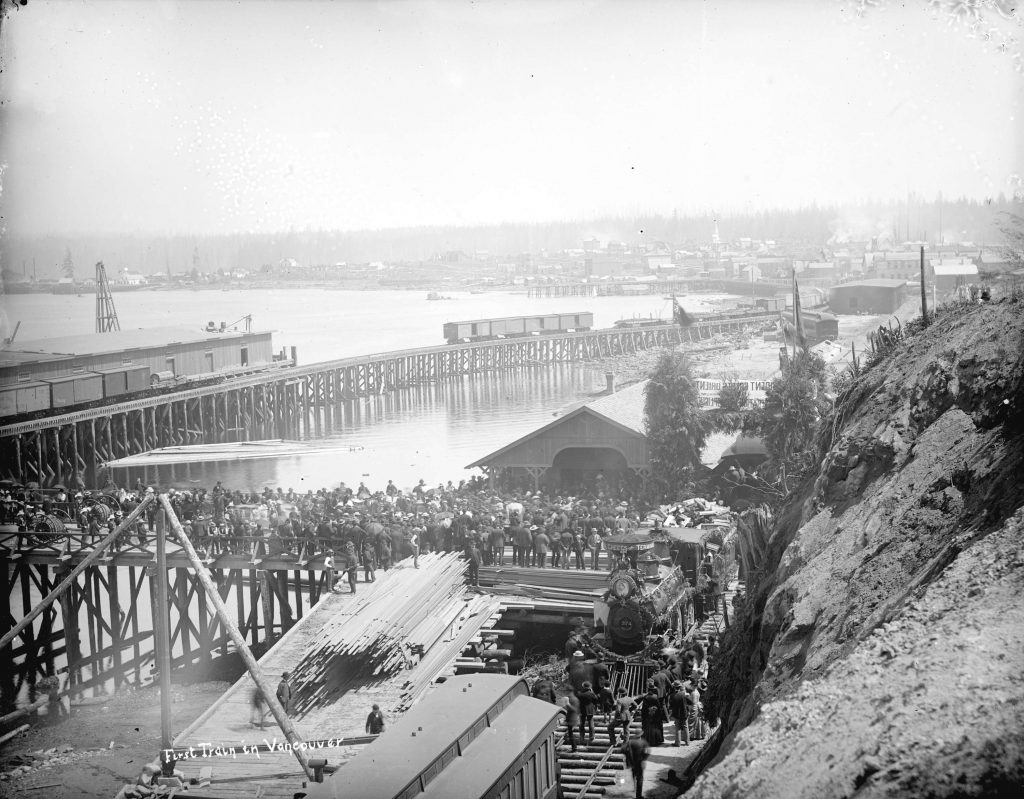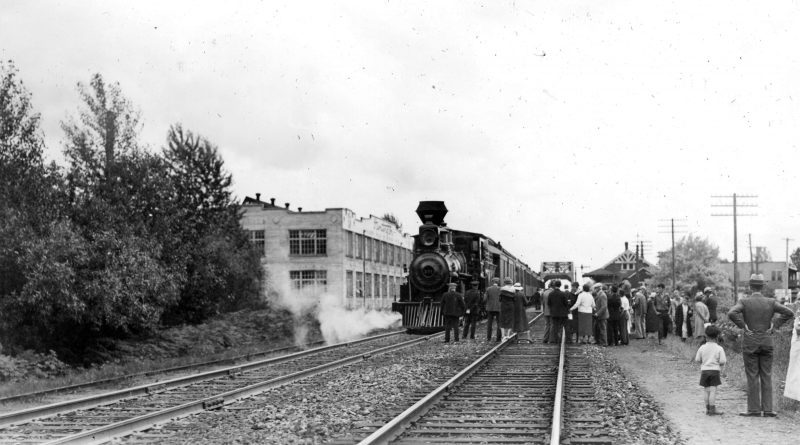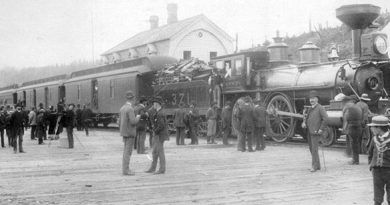CPR Comes to Vancouver
I was one of the crowd at the Roundhouse on August 11, 2006, sitting in the shadow of the famous little locomotive #374 that in 1887 hauled the first passenger train into the city. We enjoyed a brief talk on the early days of the railway here by Bernie Tully of the West Coast Railway Association and, in fact, I asked Bernie if I could reproduce his speaking notes on this site. He agreed, and here they are:
Originally seven cities up and down the coast were under review for the terminus of the proposed Trans Dominion Railway. In 1877 the Fraser River route was chosen, “terminating in Burrard Inlet.” But the location of the terminus was left unstated, and that became a hot political issue. Victoria, Esquimalt, New Westminster and two clearings in the bush, Port Moody and Gastown, jostled for the honor.
In 1880 work began on a 215-mile section between Savona and Port Moody, paid for by the Canadian government. The Canadian Pacific Railway was formed in 1881 and when the Fraser section was completed the government would give it to the CPR as a gift.
In 1881 the CPR sent its engineer John Ross to survey Burrard Inlet. He favored the site where Vancouver sits today. [CD note: Ross found the eastern end of the inlet, Port Moody, to be too shallow for ocean-going ships. Port Moody had been the first announced choice, but the CPR wanted the railway to link up to its sea-going fleet.]
In 1882-83 the railway had two choices: Coal Harbour or Kitsilano. There was lots of real estate speculation, some of it by CPR directors. Both locations had adequate acreage of flat ground for yards, repair and stores facilities.
The railway had to move with great care. It had no cash. Grants given it by the Dominion of Canada stopped at Port Moody. The land needed for right-of-way and the terminus would have to be acquired through negotiation with the BC provincial government. Negotiations followed in 1884 for the acquisition of a right-of-way from Port Moody to terminal sites “in the immediate vicinity of English Bay and Coal Harbour.” People familiar with the area knew the sites were two miles apart and separated by sea water. Where would the CPR locate the centre of the new city?
A letter to Major Rogers, CPR Surveyor, from the railway president William Van Horne, December 8, 1884 reads: “Company’s plans of Vancouver townsite must be kept from everyone, including your own engineers.”
Letters flew back and forth and on February 23, 1885 a formal contract was drawn up between the CPR and the government of British Columbia. Its provisions:
- The Company shall extend the main line of the CPR to Coal Harbour and English Bay, and shall forever thereafter maintain and equip such extension as part of the main.
- Extension to be fully completed by December 31, 1886.
- The terminus of the CPR shall be established in the immediate vicinity of Coal Harbour and English Bay.
- The Company shall erect and maintain terminal workshops and other terminal structures in the immediate vicinity of Coal Harbour and English Bay so as to provide for opening of traffic on the through line by December 11, 1886.
- Survey of the line to be taken at once.
- No Chinese shall be employed in the construction of the extension of the main line from Port Moody to English Bay.
In return the CPR was given an outright gift of 6,000 acres of land in the general area of the terminus and south of False Creek. (That area was heavily wooded with almost no settlers.)
In February 1886 the CPR started clearing the townsite area north and east of what would be Burrard and Drake Streets. The clearing resulted in logs and deadfalls being left piled high for months. On a hot Sunday, June 13, 1886 the fire got away from crews clearing land around the site of the Roundhouse and this was the start of the Great Fire that destroyed the new city. The fire burned ferociously and the city was destroyed in less than an hour. 880 buildings were burned, 22 people died. A new city bylaw directed that buildings were now to be of brick or stone only.
In October 1886 the city council of newly-born Vancouver (a name chosen by CPR president Van Horne) induced the CPR to build shops, stores and other terminal facilities on the north shore of False Creek for which the railway received 20 years of freedom from city taxes on the property. The result was the English Bay Branch and Drake Street yard.
The extension from Port Moody to Vancouver was meant to be completed by the end of December 1886, but it was not to be. Landowners in Port Moody obtained court injunctions to prevent the CPR from going on their property. These injunctions were dissolved January 5, 1887 by the Supreme Court of Canada.
Then things moved in a hurry. Vancouver heard its first locomotive whistle and saw its first train on February 23, 1887: locomotive #132 pulling four flatcars loaded with rails, ties and two cabooses came as far as Alexander Street and stayed the night. Track laying toward Coal Harbour continued the next day.
On May 21, 1887 the Construction Department handed over the Port Moody-Vancouver line to the Operating Department and on the same night the CPR staff located in Port Moody were moved by train to Vancouver to take up residence there. Two days later at 12:45 p.m. on May 23, 1887 the first transcontinental passenger train reached Vancouver Depot at the foot of Howe Street, hauled by Locomotive #374.
Bernie Tully

City of Vancouver Archives



!["Off For Sechelt" [S.S. "Sechelt"]](https://vancouverhistory.ca/wp-content/uploads/2009/12/301eedda-8cbb-4506-aee5-9d4f17f403d8-A24242-390x205.jpg)